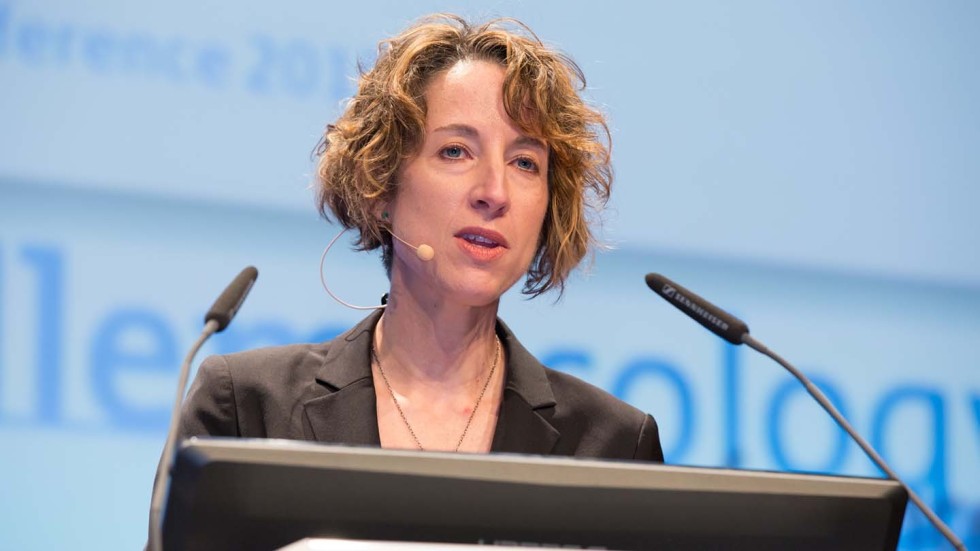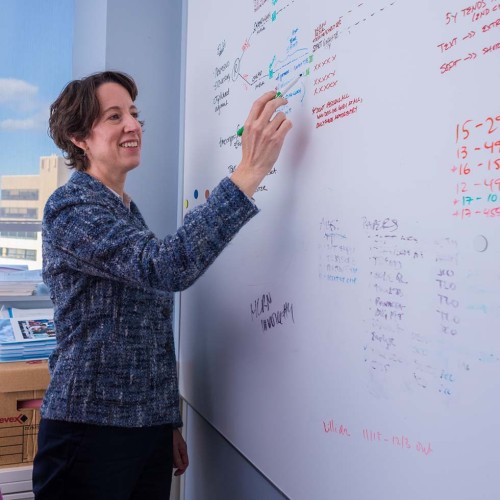
Meredith Regan ’90
Five Questions with Meredith Regan ’90
The biostatistician shares how an early path to math led to a career in breast cancer research.
When Meredith Regan ’90 came to Stonehill, she knew she wanted to be a math major. “I’m not sure I’d have said math was my favorite subject, but I always preferred puzzling through math problems,” she recalls. “It’s the logical, critical thinking and problem solving that align with how I think.”
Regan’s first-year calculus course with Professor Louise Hegarty was particularly impactful. “She was an amazing teacher who clearly elucidated concepts I’d struggled with in the past and was very encouraging. She solidified my path to math,” she notes.
And this early path is what eventually led Regan to earning a doctor of science in biostatistics from the Harvard School of Public Health and dedicating her career to breast cancer research as a biostatistician at the Dana-Farber Cancer Institute (DFCI).
“A lot of my research has focused on younger, premenopausal women with hormone-sensitive breast cancers and has contributed to breast cancer treatment guidelines used every day world-wide. But there are also the aspects of side effects, quality of life, fertility and family planning that factor into individual decisions, to which it’s rewarding to contribute knowledge through research,” says Regan, who is also a professor of medicine at Harvard Medical School and a fellow of the American Society of Clinical Oncology.
In five questions, Regan recalls a newspaper ad that sparked an enduring interest, shares the rewards and challenges of her work and notes how she finds light and hope in sharing advancements in breast cancer research.
What motivated or inspired you to focus your research on breast cancer?
My first job—“strong quantitative skills required” the newspaper job ad said—was in health economics research which led to my discovery of clinical trials and biostatistics and the ability to use my quantitative thinking in science and health research. Graduate school brought my first experiences in cancer research at DFCI. I returned to the department of biostatistics at DFCI in 2003 to work in part with the International Breast Cancer Study Group (IBCSG) located in Switzerland. The IBCSG had a strong tradition of a multi-disciplinary team science approach to clinical research—oncologists, surgeons, radiation oncologists, pathologists, statisticians, data managers and psychologists as an integrated team to improve care of people with breast cancer—in which I was excited to take part. I had spent a semester in France while at Stonehill, so the international travel associated with the IBCSG was a bonus.
What has been the most rewarding and the most challenging aspect of your work?
There are days when I’m working with a team of colleagues, discussing a challenging situation of treating breast cancer and how to best design a clinical trial or other clinical research study to provide evidence for how to provide care in this situation, and I think, “I love my job.” Most rewarding is when, as a biostatistician, my research directly impacts the care of people with breast cancer, whether for a population of breast cancer patients through the primary results of a clinical trial, or through secondary analyses with the aim to better elucidate the application of those results to individual patient decision making.
It is also challenging to work with physician-scientists who have very different knowledge and expertise, as you’re usually the only biostatistician in the room. You must build your knowledge base and keep up with the science and clinical context to understand the research question under discussion and to exert your expertise into planning a clinical research study that can provide an unambiguous answer to the research question.
Most rewarding is when, as a biostatistician, my research directly impacts the care of people with breast cancer, whether for a population of breast cancer patients through the primary results of a clinical trial, or through secondary analyses with the aim to better elucidate the application of those results to individual patient decision making.
Is there a piece of advice you often share with your students and/or scientists who are starting their career journeys?
One piece of advice for colleagues considering a career in academic medicine I can offer is that it’s extremely fulfilling because you never stop learning as science, medicine, biostatistics continually evolve, but it means you welcome the challenge of never fully knowing how to do your job.
Can you share a lesson from Stonehill that continues to resonate with you today?
When I was at Stonehill, the math and computer science majors were a small group, all together in math classes year-over-year. It was my first experience studying with a partner or group, which was an introduction to working in an academic team environment as I do currently. I understand this now as peer learning, and it’s the basis of almost every daily interaction. Whether early-career or seasoned colleague, we learn from each other with every discussion.
In addition to Professor Hegarty, I had memorable professors. Brother Rene Gaudreau, C.S.C., taught my first theoretical math classes—linear algebra and abstract algebra—and set the foundation of my love for the challenge of abstract math, proofs and trying to solve problems without clear answers. Outside of math, I had professors, such as Professors Richard Coogan and Greg Shaw in religious studies and Professor Dolores Shelley in literature, who challenged the creative, non-objective parts of my thinking. I remember learning how to hear and feel a poem for the first time through the French language. For me it was the entirety of the Stonehill education experience that taught me how to think. I didn’t know it as I entered, but it was exactly what I wanted from college.
Stonehill’s motto is Lux et Spes or Light and Hope. What does this mean to you or how does this relate to your work?
My husband and I proudly wear DFCI “swag,” golf shirts, fleeces and caps. So often, people we meet comment that they’ve had an experience there, which means a cancer diagnosis for a loved one. They proceed to share positive experiences with staff members they encountered during a difficult time and to express gratefulness for the clinicians who provide care. When I explain I’m a researcher, they ask about progress curing cancer, and I’m able to share my knowledge of advancements in cancer research, including some from my own research.
Photo Credit: Top, St. Gallen Oncology Conference | Middle, © Dana-Farber / Sam Ogden

